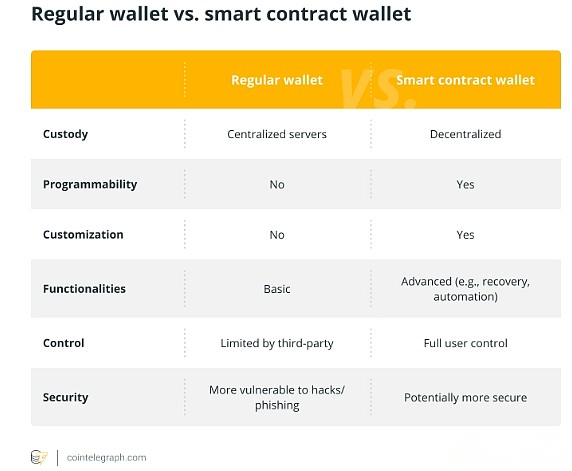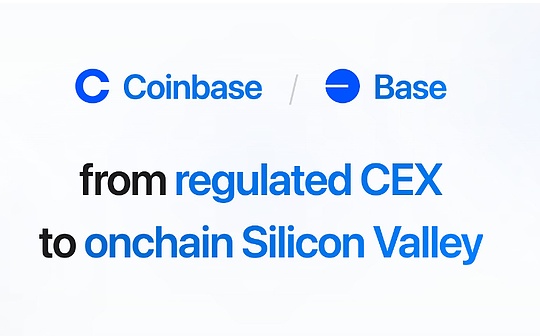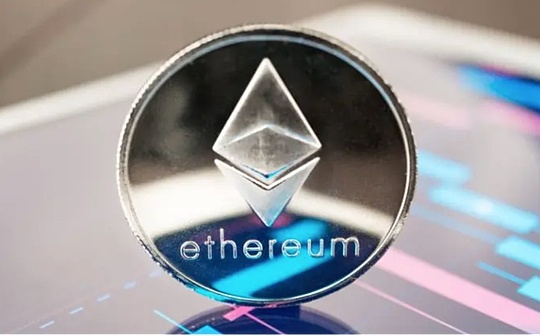
Author: Dilip Kumar Patairya, CoinTelegraph; Compilation: Baishui, Bitchain Vision
1. What is a smart contract wallet?
Smart contract wallets are scripted protocols that automatically execute agreements, which can automatically execute agreement terms and provide users with more functions and security than traditional wallets.
Smart contract wallets are considered decentralized applications (DApps) because they are built on a blockchain that enables users to manage their digital assets using smart contract technology.These wallets provide users with a way to self-custody crypto assets.In addition, they promote features such as bundled transactions, the ability to pay Gas fees in different tokens, customizable recovery options, and more.
The advantages of smart contract wallets include:
Better security
To prevent assets from being stolen or unauthorized access, smart contract wallets use encryption methods and blockchain technology.The wallet securely stores and encrypts the user’s private keys, making it harder for hackers to access users’ funds.
transparency
All transactions and smart contract codes exist on the blockchain, enabling transparency.For example, if a user suspects fraud, he or she can view his or her transaction history on the block browser to verify the accuracy of his or her wallet record.
Decentralization
Due to decentralization, smart contract wallets reduce sensitivity to censorship and single point of failure.
Customizable features
Smart contracts provide users with customizable features such as spending restrictions, multi-signature transactions and programmable rules to customize controls of digital assets according to individual needs.
2. What are the use cases of smart contract wallets?
Smart contract wallets enhance the functionality of the Web3 ecosystem in a variety of ways, such as accessing DeFi services, decentralized identity, asset management, voting systems, and more.
Smart contract wallets can be used for a variety of purposes, including fast payments, lending, trading tokens, providing liquidity, interacting with DApps, and integrating with decentralized exchanges.Here are some use cases for smart contract wallets:
Get DeFi services
The integration features in smart contract wallets enable users to access various decentralized finance (DeFi) platforms directly from the wallet.Users can conduct DeFi activities such as asset lending without relying on traditional financial institutions.Additionally, users can interact with DeFi services by connecting smart contract wallets to these platforms.
Decentralized Identity
Smart contract wallets can become an integral part of the decentralized identity system.By keeping data in smart contracts, people can have better control over what they can do with this data and how they can access it, thereby reducing the possibility of identity theft while preserving privacy.
Security Asset Management
Features such as multi-signature and configurable access control make smart contract wallets a solution for individuals and organizations to securely manage digital assets.For example, businesses can increase the security of their digital assets by using smart contract wallets to limit access to authorized employees only.
Collaborative decision-making
Organizations or groups can use smart contract wallets to ensure spending decisions are made collectively.For example, nonprofits may use multi-signature smart contract wallets to free up cash.The wallet requires the consent of several board members before freeing up cash, making the process (and the underlying stakeholders) more responsible.
Voting System
Using a smart contract wallet can make the voting process more transparent and efficient.Each smart contract reflects one vote.Tracking the voting process on a distributed ledger helps maintain election integrity and prevent manipulation attempts.
3. What is the role of multi-signature smart contracts in Web3?
Multi-signature wallets require multiple approvals to perform operations.They ensure that the actions taken are approved by the majority of signatories.
Multi-signature or multi-signature smart contract wallets require approval from multiple signers to conduct transactions.The wallet adopts the “m-of-n” signature principle, which means that to approve a transaction, m of the specified n signers are required to agree.The use of multi-signature methods adds an additional layer of security to the wallet, enhancing its resistance to hacking attacks.
The n value represents the total number of selected signatures.Each signature has its own unique private key.As n value increases, the wallet becomes more dispersed and safer.The m value represents the minimum signature required to authorize the transaction.
An example will help us better understand the functionality of a multi-signature wallet.In the 3-of-4 multi-signature wallet, there will be four signers (n = 4), and the execution of the transaction will require approval from at least three of the signers (m = 3).
4. How to enhance the functions of smart contract wallets in ERC-4337?
ERC-4337 brings an account abstraction approach that eliminates links to external accounts (EOA) and promotes more creative and user-friendly design.
Prior to ERC-4337, smart contract wallets often faced restrictions.They sometimes interact with EOA, which still involves private key management and may require centralized repeaters to execute transactions.Blockchain repeaters are third-party services that help data move and communicate between various blockchain networks.This reliance on external entities is a concern for projects that strive for full decentralization.
ERC-4337 is an account abstraction method that allows people to use smart contracts as their primary account and eliminates centralized repeaters, EOAs, or private keys.Thanks to ERC-4337, wallets can be designed with more creative and user-friendly.It enables developers to integrate wallets with advanced features such as automatic payments, unique wallet recovery technology, and multi-factor authentication.These wallets are safer, more user-friendly and more versatile.
5. Smart contract wallet vs. ordinary wallet
The difference between a regular wallet and a smart contract wallet is their functionality and goals.
Regular or external Ethereum wallets enable users to store, manage and interact with their digital assets on the Ethereum blockchain.These digital assets may include Ethereum (ETH), Ethereum’s native cryptocurrency and other ERC-20 tokens.To allow users to access and manage their funds, each wallet generates a unique public address and corresponding private key or seed phrase.With these wallets, people can perform basic tasks such as sending and receiving Ethereum virtual machine (EVM) compatible tokens and tracking transaction history.
On the other hand, a smart contract wallet is a programmable wallet that can facilitate more automation and complex interactions.It enables users to implement two-factor authentication (2FA) (adding an additional layer of protection to funds), sign transactions on their phones, set monthly spending limits, generate session keys (temporary encryption keys for a single session or transaction).) Play blockchain games, automatic bill payment, decentralized wallet recovery, and more without continuous transaction approval.

6. What are the risks and precautions for smart contract wallets?
Developing smart contract wallets requires advanced technical knowledge.They must also be wary of human errors that lead to irreversible transactions being sent to the wrong address.
Like all technologies, smart contract wallets have their potential drawbacks:
Programming complexity
Developing and maintaining a smart contract wallet is a complex task that requires developers to have advanced technical knowledge.Any vulnerability in the backend will provide criminals with room to infiltrate.
Irreversible transaction
Although automation is a core feature of smart contract wallets, vulnerabilities or errors in programs can lead to unexpected losses or transfers, which is irreversible.
Early technology
The technology behind smart contract wallets is still evolving.In order to be able to use smart contract wallets effectively, people need to be aware of the latest developments.
Human error
Complex smart contract wallets require precise programming.Human errors can always lead to vulnerabilities.








